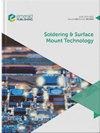模拟波峰焊接过程的表面安装元件剪切力的实验测量
IF 1.7
4区 材料科学
Q3 ENGINEERING, ELECTRICAL & ELECTRONIC
引用次数: 2
摘要
目的本研究旨在通过实验和数值程序确定在波峰焊过程中拔出印刷电路板(PCB)表面安装组件所需的最小力。设计/方法/方法提出了一种有效的实验技术,以确定在波峰焊过程中拔出PCB表面安装组件所需的最小力。结果表明,拉拔力约为0.4 N.将该值与焊接波施加在部件上的模拟力进行比较(Ş0.001158 N) 可以得出结论,焊接波没有施加足够的力来移除部件。独创性/价值这项研究深入了解了关于部件拔出的波峰焊工艺,这是微电子行业在该焊接工艺中通常会出现的一个关键问题。通过应用精确的实验和数值方法,这项研究表明,需要更多的测试来评估这一问题的主要原因,并为PCB上胶点的沉积过程提供了新的见解。本文章由计算机程序翻译,如有差异,请以英文原文为准。
Experimental measurements of the shear force on surface mount components simulating the wave soldering process
Purpose
This study aims to determine the minimum force required to pull out a surface mount component in printed circuit boards (PCBs) during the wave soldering process through both experimental and numerical procedures.
Design/methodology/approach
An efficient experimental technique was proposed to determine the minimum force required to pull out a surface mount component in PCBs during the wave soldering process.
Findings
The results showed that the pullout force is approximately 0.4 N. Comparing this value with the simulated force exerted by the solder wave on the component (
≅ 0.001158 N), it can be concluded that the solder wave does not exert sufficient force to remove a component.
Originality/value
This study provides a deep understanding of the wave soldering process regarding the component pullout, a critical issue that usually occurs in the microelectronics industry during this soldering process. By applying both accurate experimental and numerical approaches, this study showed that more tests are needed to evaluate the main cause of this problem, as well as new insights were provided into the depositing process of glue dots on PCBs.
求助全文
通过发布文献求助,成功后即可免费获取论文全文。
去求助
来源期刊

Soldering & Surface Mount Technology
工程技术-材料科学:综合
CiteScore
4.10
自引率
15.00%
发文量
30
审稿时长
>12 weeks
期刊介绍:
Soldering & Surface Mount Technology seeks to make an important contribution to the advancement of research and application within the technical body of knowledge and expertise in this vital area. Soldering & Surface Mount Technology compliments its sister publications; Circuit World and Microelectronics International.
The journal covers all aspects of SMT from alloys, pastes and fluxes, to reliability and environmental effects, and is currently providing an important dissemination route for new knowledge on lead-free solders and processes. The journal comprises a multidisciplinary study of the key materials and technologies used to assemble state of the art functional electronic devices. The key focus is on assembling devices and interconnecting components via soldering, whilst also embracing a broad range of related approaches.
 求助内容:
求助内容: 应助结果提醒方式:
应助结果提醒方式:


